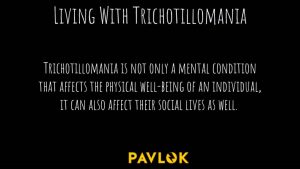[et_pb_section admin_label=”section”]
[et_pb_row admin_label=”row”]
[et_pb_column type=”4_4″]
[et_pb_text admin_label=”Text”]

Trichotillomania, also known as compulsive hair pulling disorder, is a very real condition that affects up to 3.4 percent of the world population (source.)Similar to other compulsive behaviors such as gambling and food addiction, those affected with Trichotillomania struggle to control their actions, many times pulling their hair without even realizing.
A brief overview of Trichotillomania by therapist Kati Morton
In addition to suffering drastic physical effects, those with Trichotillomania often display noticeable hair loss most commonly on their scalp or eyebrows, though hair pulling is not limited to these areas. Because of their condition, it often affects their ability to interact with others socially and many times carries negative consequences in their career and relationships.
While there are many theories for the cause of Trichotillomania, growing evidence to suggests the compulsive behavior is caused by stress, anxiety, depression and/ or additional mental disorders. “Over 60% of the individuals studied by Flessner and colleagues were suffering from both TTM and another mental disorder. Some of these previous conditions may have been related to phobias, obsessive-compulsions, and substance abuse disorders.”
Furthermore, “a neurocognitive model sees — the notion that the basal ganglia plays a role in habit formation and that the frontal lobes are critical for normally suppressing or inhibiting such habits — sees Trichotillomania as a habit disorder..[6]
Despite Trichotillomania affecting many people around the world the good news is there are many solutions to help improve the Trichotillomania condition.
Trichotillomania Stop Pulling Your Hair For Good – Treatment And Solutions
Because of this unique condition, many individuals affected by Trichotillomania do not get the proper care needed to help control their compulsive behavior. However, with the proper steps and resources, there are numerous solutions to help reduce the impact the condition has. “Treatment is typically with cognitive behavioral therapy. The medication clomipramine may also be helpful.[3] In addition, simply generating awareness about the desire to pull one’s hair has proven to be very effective in reducing the amount of actual hair pulling.
Discover How User Namoi Use Pavlok To Stop Pulling Her Hair
As with many habitual behaviors, once the habit pattern is interrupted, it is significantly easier to replace the hair pulling behavior with something that is more productive such as doing pushups or getting a glass of water.
While we believe one should approach Trichotillomania with a variety of approaches to ensure success, Pavlok has helped hundreds of people all around the world reduce their compulsive behaviors and regain control of their life. Simply by zapping yourself before, during, and after each hair pulling action you can quickly create awareness around your triggers and reduce the urge to pull your hair.
Given the science suggests Trichotillomania is a habit related disorder, Pavlok can help you reduce your hair pulling in just a few short weeks or in some cases as little as one day.
If you want to stop pulling your hair, there are many solutions you can try. We believe Pavlok can help you succeed.
[/et_pb_text]
[/et_pb_column]
[/et_pb_row]
[/et_pb_section]
